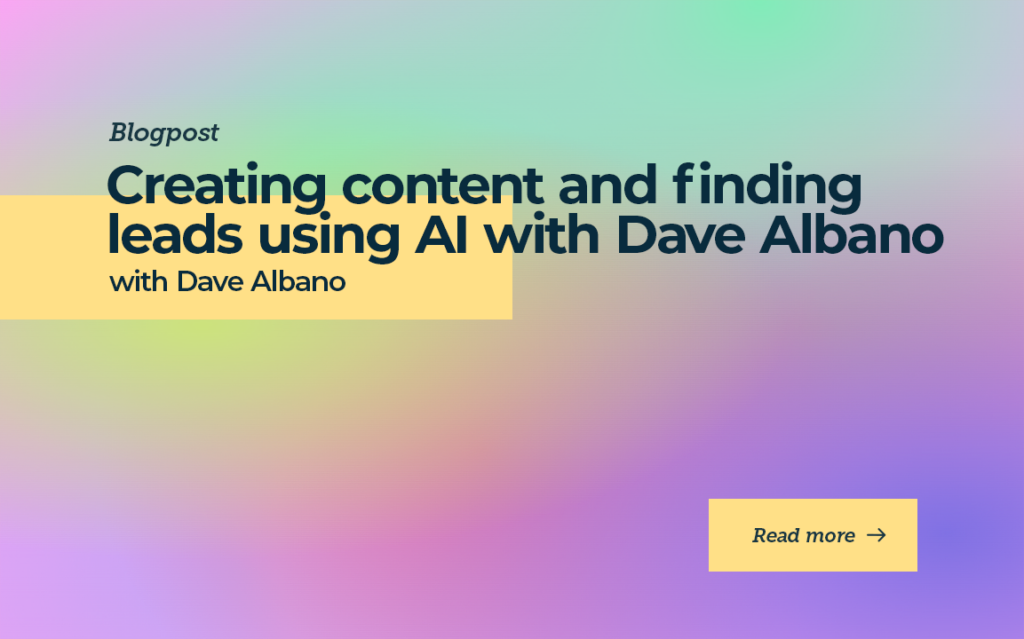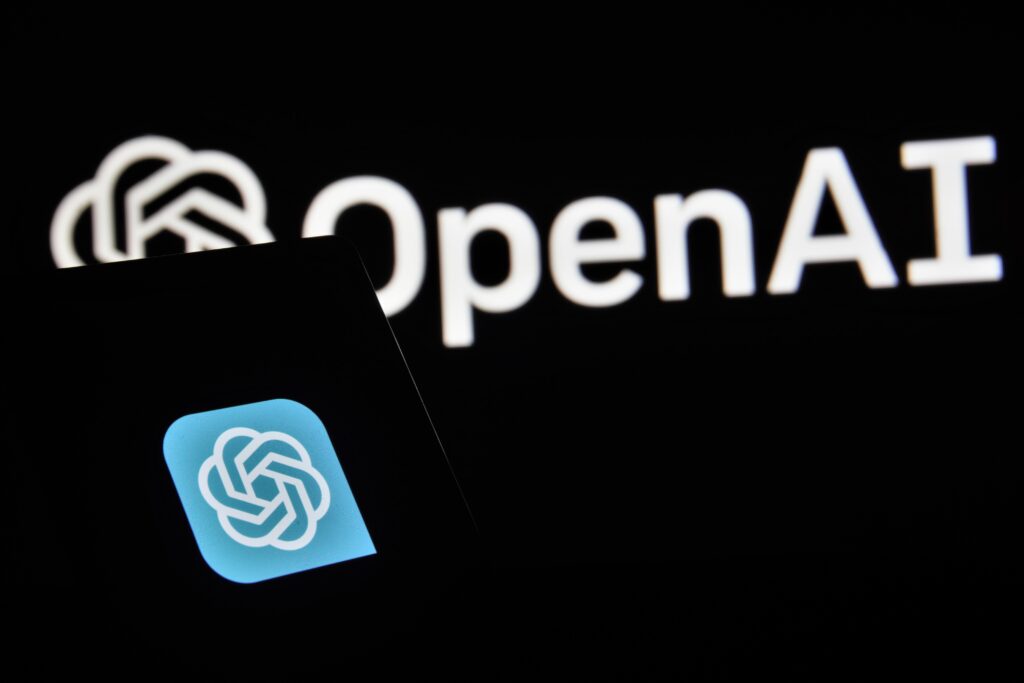Creating Content and Finding Leads Using AI with Dave Albano

In this episode, our host, Collin Stewart, sits down with Dave Albano, a fractional CMO with a knack for leveraging AI in the sales and marketing landscape. Collin was particularly impressed by Dave’s “super prompt,” a specialized AI prompt that has significantly improved the quality of Collin’s own AI-generated content.
If you’ve ever wondered about the real-world applications of AI in sales and marketing, this episode is your go-to resource.
AI: More Than Just a Buzzword
AI is often tossed around as a buzzword, but in this episode, we cut through the noise to focus on its practical applications. Dave Albano brings a refreshing perspective, emphasizing that AI is not just a theoretical concept but a tool with real-world applications. He shares specific use-cases where AI can be a game-changer, from enhancing productivity to content creation and lead generation.
- Content Creation: Dave doesn’t merely rely on AI to generate content; he uses it as a starting point. He takes the AI-generated base content and infuses it with his own style, stories, and expertise. This hybrid approach ensures that the content is high-quality and uniquely human.
The Practical Side of AI
AI is not just for tech enthusiasts; it’s a tool that can solve everyday challenges. Dave Albano recommends turning to AI when you encounter mental roadblocks. AI can offer innovative solutions, whether it’s writer’s block, a complex task, or a creative challenge.
- Mental Roadblocks: Dave suggests using AI as a brainstorming partner. When you hit a mental block, AI can provide a new angle or approach you might not have considered, helping you move forward.
- Fact-Checking: Dave also highlights the importance of fact-checking AI-generated content. AI can sometimes produce incorrect or misleading information, which he calls “hallucinations.” Always validate the information before using it in any official capacity.
The Art and Science of Writing with AI
Collin shared his own experiences with AI, particularly in writing. He finds that AI can be invaluable for breaking through writer’s block and refining complex ideas. However, he also emphasizes that the output quality is highly dependent on the quality of the input.
- Quality Over Quantity: Collin points out that while AI can generate a large content volume, the focus should be quality. A well-crafted prompt can yield much better results than a hastily written one.
- Human Element: Dave agrees that AI can be particularly useful for generating outlines and structuring content. However, he stresses that the human element should not be lost. Your stories, experiences, and expertise should always be at the forefront, making the content relatable and engaging.
Leveraging AI for Personal and Business Productivity
Collin emphasizes the critical role of asking for clarifications, especially when buzzwords are thrown into the conversation. He uses GPT while in meetings with clients. This practice demystifies the dialogue and fosters a deeper connection with the client.
He takes this principle a step further by applying it to personal productivity. Collin shares a personal anecdote where he used AI to generate a recipe. He received a highly tailored and useful output by asking the AI specific questions and providing detailed context, such as the ingredients he had and his dietary restrictions.
This underscores the universal applicability of the “art of asking”—whether you’re negotiating a deal on a sales call or seeking a personalized recipe from an AI, the quality of the questions you ask and the context you provide can significantly impact the results you get.
Customization and Personalization: The Rise of AI Assistants
Dave dives into the fascinating world of AI customization through what he calls a “super prompt.” This advanced feature allows users to create highly personalized AI assistants. But Dave argues that the journey of personalization starts with something as simple as naming your AI assistant. According to him, giving your AI a name humanizes the interaction and psychologically primes you to receive personalized advice.
This assistant isn’t just a code; it can ask you clarifying questions, understand your preferences, and even offer actionable recommendations tailored to your needs. The level of customization is so high that the AI can adapt its responses based on the context and nuances of your requests, making the AI experience not just personalized but also incredibly effective.

Advanced Strategies for Maximizing AI Capabilities
Dave Albano opens up a new horizon for AI applications in business. While many are familiar with using AI for email copywriting, Dave points out that its capabilities are far more extensive, extending even to code generation.
This versatility makes AI an invaluable asset in modern business operations. It can automate various specialized tasks, from content creation to technical coding, freeing human resources for more strategic activities. This broad range of applications positions AI as a transformative force in the business landscape.
Combining AI Tools and Humanizing AI
Dave advocates for a multi-faceted approach to AI utilization. On one hand, he talks about the advantages of combining different AI tools for specific tasks. For instance, one tool could be optimized for content creation, while another could excel in graphic design.
On the other hand, Dave introduces the concept of custom instructions in GPT, which allows users to make their interactions with AI more human-like. He emphasizes that while AI can be a powerhouse of efficiency, the final output often needs a human touch for genuine engagement and relatability.
This balanced approach, leveraging multiple AI tools while also humanizing their output, creates a comprehensive strategy for maximizing the benefits of AI.
AI for Enhanced Communication
The use of GPT can be as varied as your daily tasks. One moment you might be asking it to infer context from a message, and the next, you could ask a broad, open-ended question.
Dave suggests that adding a “super prompt” can help you get more specific and contextual answers, especially useful for tasks like copywriting or productivity. The idea is to use the prompt format as a template for creating any kind of AI assistant tailored to your needs.
General and Business-Specific Queries with Context-Specific AI Assistants
Dave emphasizes that your AI assistant can be as general or specific as you need it to be. Whether you’re using it for research, recipes, or business-specific questions, the key is to balance its capabilities.
Collin adds an interesting twist by suggesting you could have multiple AI assistants for different contexts. You could even name them (Dave named his Ava) after famous AI characters from movies like “Her” or “iRobot,” making the interaction more engaging.
Power of AI in Copywriting: Overcoming Writing Bottlenecks
AI’s capabilities in copywriting are not just about speed and efficiency; it’s also about style. Dave points out that you can instruct the AI to write in the style of famous authors like Mark Twain or John Hemingway.
On the flip side, if writing is your bottleneck, Collin shares that AI can be a lifesaver. By asking the AI to clarify or articulate ideas, you can overcome personal writing challenges and produce compelling content.
The Transformative Impact of AI and Writing in Sales
Writing is essential in sales, especially for smaller companies without a large marketing team. Salespeople often find themselves becoming “mini content creators,” as Collin puts it.
AI can be a significant asset in this context. It can assist in customer communication by answering questions and generating content around them, making the sales process more efficient and effective.
Dave suggests a unique application of AI in sales: objection handling. By feeding your most frequent objections into the AI, you can generate well-crafted responses that can be turned into FAQs for your website. This not only addresses customer concerns but also enhances your online resources.
The role of AI in sales is expanding, and its capabilities in overcoming objections and answering customer questions are becoming increasingly important.
Writing plays various roles in business, from content creation to sales and customer communication. Dave ties this back to sales by stating that writing is essentially sales; it’s used everywhere from sales pages to SEO and blog writing. AI can be a powerful tool in boosting productivity in these writing-intensive tasks.
Whether it’s creating video scripts for YouTube or generating world-class sales copy, the implications are vast and directly tied to business success.
Insights on Context, Client Management, and Data Analysis
Context Preservation in Chatbots
- The Query: How much context is saved during interactions?
- The Reality: Fresh start needed each time; long threads can preserve some context but tend to forget if it’s way back.
Pro Tip: “Do you remember our previous chat?”—a prompt that cues the chatbot to scan and summarize past interactions, ensuring it’s still on track.
Client-Specific Chats
- The Strategy: Use separate chats named after each client (e.g., ava-client1, ava-client2).
- The Advantage: Context remains client-specific; no need for constant retraining.
The Caveat: While it helps remember client-specific details, it doesn’t completely eliminate the need to refresh context.
Chatbots in Reporting
- The Curiosity: Can chatbots assist in reporting tasks?
- The Potential: Untapped but promising; Dave’s not currently using it for reporting but he sees a future application.
The Future: Could be used to interpret data and translate it into human-understandable terms.
Advanced Features for Data Analysis
- The Tool: Code Analyzer for advanced data scrutiny.
- The Process: Enable Code Analyzer under settings, then go to GPT-4 and click the advanced data analysis checkmark.
- The Challenge: Multi-step processes can be complex; context preservation is limited. Must loop through one variable at a time for effective analysis.
The Experience: Collin uses it to analyze customer data, enriching it from multiple data sources, and finds it efficient but challenging for multi-step tasks.
Expert Advice for Maximizing Chatbot Utility
- The Suggestion: Use prompts to ask the chatbot to look for trends, interpret data, and infer meanings.
- The Super-Prompt: A super prompt can be crafted to write other prompts and use those to create AI assistants for different tasks.
Introducing the Super Prompt
It’s not just a question or a command; it’s a multi-layered directive that tells the chatbot exactly what you need. Think of it as a prompt within a prompt, designed to elicit the most accurate and useful response from your AI assistant.
Being specific in your prompts is like giving a chef a detailed recipe. The outcome is bound to be more to your liking.
The more specific you are, the better the chatbot can serve you. For example, instead of asking for legal advice, ask for “family law advice in the jurisdiction of Washington, DC.” The devil is in the details, and so is the key to effective AI interaction.
The Power of Custom Instructions in Chatbots
Custom instructions aren’t just a feature; they’re a game-changer. Imagine walking into a room where everyone knows your name, what you do, and how you like your coffee.
That’s what custom instructions do for your chatbot experience. They set the stage, providing the bot with a nuanced understanding of your business to serve you better. For instance, if you want to generate leads, custom instructions can guide the bot to offer solutions tailored to your industry and target audience.

The Iterative Process for Better Responses
First drafts are rarely perfect, and the same goes for prompts. If the chatbot’s first response doesn’t hit the mark, iterate. Use numbering in your prompts for easy reference and feedback. This iterative process not only refines the bot’s understanding but also leads to more creative and effective solutions.
The Importance of Customer Avatars in Sales
Understanding your customer is Sales 101. But how deep does your understanding go? With Chat GPT, you can flesh out your customer avatars like never before. Dive into the psyche of your target audience, exploring their needs, wants, fears, and aspirations. This isn’t just data; it’s actionable insight that can guide your sales strategies.
The Business Impact of AI-Driven Strategies
AI isn’t just a tool; it’s a strategy enabler. AI can significantly impact your business outcomes by providing specific, tailored advice. For instance, a generic strategy might tell you to focus on digital marketing, but an AI-driven approach will align strategies with your unique business goals, like attracting seven-figure businesses.
Practical Applications: Lead Generation Strategies
Whether it’s inbound marketing through SEO and content or outbound efforts like cold emailing, the strategies for lead generation are numerous.
But what about adding a creative flair?
Imagine a “Double Your Revenue Challenge,” a 30-day online event targeting seven-figure companies. It’s not just a webinar; it’s an experience and a lead magnet.
Boutique Agencies and the White-Glove Approach to AI
AI can be a significant value add for boutique agencies that offer white-glove services. It allows these agencies to provide customization and insight that sets them apart from the competition.
Take Joza Marketing, for example, which uses AI to offer its clients a unique, high-touch experience.
Staying ahead of the curve is not just an advantage; it’s a necessity. Adopting AI-driven strategies can keep businesses relevant, offering them tools and insights that were previously unimaginable.
Conclusion
it’s evident that AI is more than a buzzword—it’s a transformative tool for today’s businesses. Dave’s “super prompt” and customization tips reveal how AI can offer personalized, human-like interactions. Collin’s practical applications demonstrate that the effectiveness of AI is directly tied to the quality of your questions and context.
The takeaway is clear: AI is not just the future; it’s shaping businesses now. From content creation to customer engagement, its applications are vast and impactful. Don’t wait for tomorrow; the tools for transformative business success are already at your fingertips.
NO TIME TO READ?
Listen On:



